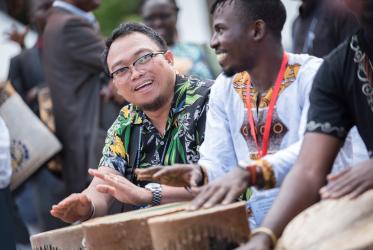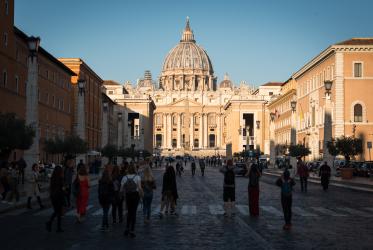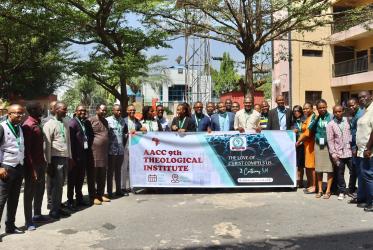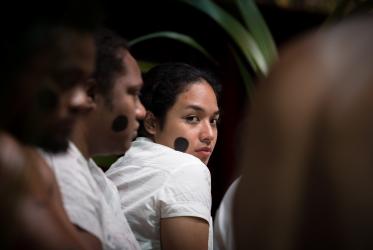By Odair Pedroso Mateus*
Tell me, how can you seriously engage with the theme of this assembly - “Man’s Disorder and God’s Design” - if on Monday afternoon Karl Barth, shaking a Basel Herr Professor finger prophesied that it is wrong, it should be the other way round, “God’s Design” first and only then “Man’s Disorder”?
And yet we must study it hard whatever the order. This seems the only way for ecumenical work to be convincing, to break new ground. An organisation with no legislating authority like the WCC must pursue excellence in its programmatic work, study, and staffing otherwise it may condemn itself to irrelevance.
That’s why Archbishop Temple, in the Explanatory Memorandum accompanying the 1938 letter inviting churches “to take part in the establishment of a World Council of Churches” wrote that the WCC authority “will consist in the weight it carries with the Churches by its own wisdom”, in other words by the quality, timeliness, relevance of its work and the high competence of those who do it.
Joseph Oldham understood it earlier. Preparing Life and Work 1937 he invited “an exceptionally strong group” of speakers and edited the “Oxford Series”: seven volumes on the theme of the conference: “Church, Community, and State”.
The Amsterdam assembly, though prepared in a hurry, followed in its preparation the search for excellence that made of the 1937 Life and Work world conference a milestone in Christian resistance to growing totalitarianism. No wonder four volumes were waiting for me at the Post Office early in June. I immediately thought of the great Oldham when I opened the first volume and read “The Amsterdam Assembly Series”.
Each of the four volumes is related in a different way to the assembly theme (whatever its order…), and prepares the participants for the serious study of one of the four assembly Sections: The Universal Church in God’s Design; The Church’s Witness to God’s Design; The Church and the disorder of Society; and The Church and International Disorder.
These four sections correspond exactly to four areas of ongoing WCC work: Faith and Order; Mission; Life and Work (which will soon become the WCC Department of Study); and International Affairs.
Gustaf Aulén, Karl Barth, Georges Florovsky, and Edmund Schlink have contributed to the Section I volume. The other three volumes include contributions by Paul Tillich, Emil Brunner, Jacques Ellul, Reinhold Niebuhr, and the famous cold war duo John Foster Dulles/Josef Hromadka.
Many of them are attending the assembly, which has led a delegate to say something like “my whole library is present in Amsterdam”.
As I read the list of Section I participants, I’m taken by sympathy for Oliver Tomkins, Faith and Order secretary and drafter of Section I Report. I imagine he feels like Daniel at the lions’ den.
In fact, since a preparatory meeting held in Bossey in February last year I find Tomkins, the future Bishop of Bristol, a bit concerned with the theological work of Section I, where continental Lutherans and Reformed keep insisting on die Grunddifferenz, a fundamental difference or division between Protestants and Catholics.
Too much focus on this “Protestant” versus “Catholic” fundamental difference, Tomkins is afraid, may put in risk almost forty years of patient Anglican-led Faith and Order theological work with Eastern Orthodox and Scandinavian Lutherans (and therefore with Roman and Old Catholics) precisely on the universal Church in God’s design.
Now Section I is seriously at work. If one day he writes his memories, Tomkins will certainly refer to his “sense of sheer despair” after the first two sessions. After one meeting or two, he will write, “nothing was clear except the depth of our disagreement”.
Oh Oliver… think positively and keep in mind that the Swiss Barth draws inspiration from stiff hillsides facing each other while you Anglicans believe yourselves (right or wrong according to the Non-Conformists) predestined to build bridges (and railways…) between them. Who could say today that within four years you will author a book on Faith and Order precisely with the vindicating title “The Church in the Purpose of God”?
We finally have a Section I Report. Tomkins, who worked on this Report until 3 a.m. is now relieved if not euphoric. He says that having read it, Karl Barth told him: “I think you have succeeded in squaring the circle.”
Let me quickly walk you through the Report’s six steps.
1. The first is the recognition and affirmation that God has given us unity in Christ through the Holy Spirit “notwithstanding our divisions”. It is our common concern for Christ’s Body that “draws us together” and leads us to “discover our unity” in relation to the Lord and Head of the Church.
2. Our oneness in Christ allows us – second step - to face “our deepest difference”: From each side of the division, “we see the Christian faith and life as a self-consistent whole, but our two conceptions of the whole are inconsistent with each other”.
Our “deepest difference” is made clear in two conflicting types of describing the nature and mission of the Church called precisely “Catholic” and “Protestant”. Each constitutes “a whole corporate tradition”. The Catholic type contains “a primary insistence upon the visible continuity of the Church” while the Protestant type “primarily emphasizes the initiative of the Word of God and the response of faith.”
As a result, “we have not been able to present to each other the wholeness of our belief in ways that are mutually acceptable”.
3. Due to our “deepest difference”, our elementary agreements about the nature and mission of the Church give room to disagreements when they are submitted to a “closer examination”.
4. Thus our ecumenical situation can be described in three layers: as we gather to talk about unity, we are faced by “stubborn problems”; we then realize that our disagreements are to be traced back to our deepest difference; and finally, beneath our deepest difference, “we find again an agreement in a unity which drew us together and will not let us go”.
5. The fifth step is dedicated to the pilgrim Church: “within our divided churches, there is much which we confess with penitence”. Pride, self-will and lovelessness “have played their part” in existing divisions. Because of our sin “the evils of the world have so deeply penetrated our churches”. There are churches segregated by class division, race and colour, which is “a scandal in the Body of Christ”.
6. Thus the World Council of Churches has come into existence “because we have already recognised a responsibility to one another’s churches in Our Lord Jesus Christ. We embark upon our work in the WCC “in penitence for what we are, in hope for what we shall be”.
During the Report discussion in plenary, the Indian V. E. Devadutt and his Sri-Lankan colleague D.T. Niles remark that the content of the Section I Report reflects the European ecumenical situation and consequently lies behind ecumenical development in Asia where some churches have just united and others are involved in union negotiations. Niles says the same, but with a metaphor: the Older Churches are still discussing “the reasons and circumstances that have led them to their earlier divorce” whereas the Younger Churches in Asia are “just getting married”.
*Odair Pedroso Mateus is a director of the Faith and Order Commission of the World Council of Churches (WCC).
#WCC70 Amsterdam, 1948 (1): Covenanting in prayer
#WCC70 Amsterdam 1948 (2): Covenanting in work: What on earth is the World Council of Churches?
70 years of the World Council of Churches








